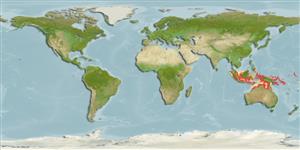>
Ovalentaria/misc (Various families in series Ovalentaria) >
Ambassidae (Asiatic glassfishes)
Etymology: Ambassis: Derived from Greek, anabasis = climbing up (Ref. 45335).
Eponymy: Rev George Harvey Vachell (1799–1839) was chaplain to the British East India Company’s factory at Macao. [...] (Ref. 128868), visit book page.
More on author: Richardson.
Environment: milieu / climate zone / depth range / distribution range
Écologie
marin; eau douce; saumâtre démersal; océanodrome (Ref. 51243). Tropical; 5°N - 17°S
Indo-West Pacific.
Taille / Poids / Âge
Maturity: Lm ? range ? - ? cm
Max length : 6.5 cm SL mâle / non sexé; (Ref. 44894)
Épines dorsales (Total) : 8; Rayons mous dorsaux (Total) : 9; Épines anales: 3; Rayons mous anaux: 9.
Found in brackish waters of bays, estuaries and tidal mangrove creeks, sometimes entering fresh water (Ref. 2847, 44894). Occurs in lotic and lentic freshwater (Ref. 7300).
Life cycle and mating behavior
Maturité | Reproduction | Frai | Œufs | Fécondité | Larves
Paxton, J.R., D.F. Hoese, G.R. Allen and J.E. Hanley, 1989. Pisces. Petromyzontidae to Carangidae. Zoological Catalogue of Australia, Vol. 7. Australian Government Publishing Service, Canberra, 665 p. (Ref. 7300)
Statut dans la liste rouge de l'IUCN (Ref. 130435: Version 2024-1)
Menace pour l'homme
Harmless
Utilisations par l'homme
Outils
Articles particuliers
Télécharger en XML
Sources Internet
Estimates based on models
Preferred temperature (Ref.
123201): 26.9 - 29.1, mean 28.4 °C (based on 526 cells).
Phylogenetic diversity index (Ref.
82804): PD
50 = 0.5000 [Uniqueness, from 0.5 = low to 2.0 = high].
Bayesian length-weight: a=0.01202 (0.00496 - 0.02912), b=3.02 (2.83 - 3.21), in cm total length, based on LWR estimates for this Genus-body shape (Ref.
93245).
Niveau trophique (Ref.
69278): 3.3 ±0.4 se; based on size and trophs of closest relatives
Generation time: 2.1 ( na - na) years. Estimated as median ln(3)/K based on 2
growth studies.
Résilience (Ref.
120179): Haut, temps minimum de doublement de population inférieur à 15 mois (K=0.55; Assuming Fec > 10,000).
Fishing Vulnerability (Ref.
59153): Low vulnerability (24 of 100).
